I will be in touch shortly. What kind of beer and how do I get good beer in to Canada? 😛😀 When you said that Pliny the Elder and Melvin 2x4 popped into my head, what I would do for for one of those.
Oh, I'm sure we could figure out a workable solution. 🙂 I do like the IPAs. The Spacedust IPA from Elysian (Seattle) is fantastic. At the other end of the IBU spectrum, I find Rogue (Ashland, OR) Chocolate Stout to be rather orgasmic. I live within an easy (few minute) walk of a microbrewery (Elite Brewing & Cidery) that opened in July. Should you "swing by" to visit, I'm sure we can find time to visit there. 🙂
Tom
DoubleIPA - you might want to exchange some PMs with Tom re his thoughts on linear vs SMPS supplies for the 686. The unit I heard this summer was the exact same unit in his photos earlier in this thread, and it definitely had no issue with powering a pair of DIY multi-ways - albeit not as elaborate as the KEF Reference 5s. The Modulus686 is the little silver box on the floor with green power indicator.
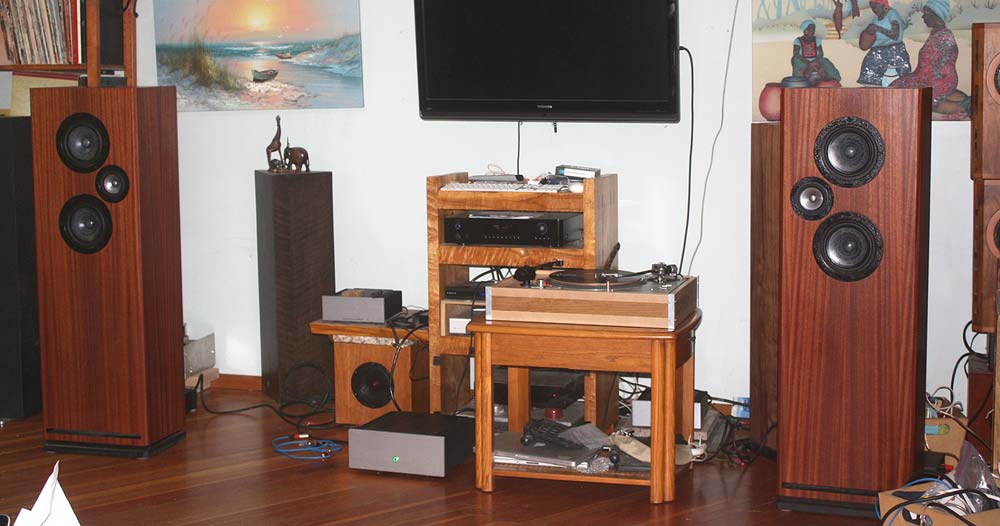
I will discuss with him. Just have a lot on my plate right now, but tonight or tomorrow he should get an email.
When I lived in SFBA I ventured up to Lagunitas and Russian River frequently. I still own my house in Colorado, but am putting it on the market soon, so I think I'll have one or two more visits in the next year or two. I'm with you, I love a good IPA and Stout. The beer scene in NZ is in it's infancy and it's very expensive and fairly average, but getting better.Oh, I'm sure we could figure out a workable solution. 🙂 I do like the IPAs. The Spacedust IPA from Elysian (Seattle) is fantastic. At the other end of the IBU spectrum, I find Rogue (Ashland, OR) Chocolate Stout to be rather orgasmic. I live within an easy (few minute) walk of a microbrewery (Elite Brewing & Cidery) that opened in July. Should you "swing by" to visit, I'm sure we can find time to visit there. 🙂
Tom
There is one potential SMPS supply option that could be a good match for a Mono Modulus-686 ±36 V build: The Connex SMPS800RE. You'd have to get a custom output voltage (±36 V), which adds $8.50. Still, that's ~$120 + shipping for the supply. Not a bad deal.
I'm normally not a huge fan of Connex as I find their specs to be pretty sparse. Thus, I'd prefer to torture test one of the SMPS800RE before making an actual recommendation. I'm quite confident that it'll pass, though.
I've had good results with the SMPS300RE on the Modulus-86 and I expect the SMPS800RE to provide good results on the Modulus-686.
I'll see if I can find enough empties to pay for an SMPS800RE next time I place an order with Connex so I can get one to test.
Tom
I'm normally not a huge fan of Connex as I find their specs to be pretty sparse. Thus, I'd prefer to torture test one of the SMPS800RE before making an actual recommendation. I'm quite confident that it'll pass, though.
I've had good results with the SMPS300RE on the Modulus-86 and I expect the SMPS800RE to provide good results on the Modulus-686.
I'll see if I can find enough empties to pay for an SMPS800RE next time I place an order with Connex so I can get one to test.
Tom
Finally i completed the last things in my build of the Modulus 686 and it is time to share some pictures and experiences.
The build in my case has been a tough ride, at first because i made a silly mistake and fried one of my Meanwell RPS-400-36 supplies, which then also fried a chip on one of the modulus modules that we had to replace. Later when i finally got the build running i found that my configuration based on four of those Meanwell’s gave both a mechanical whining noise as well as - in my case - a pretty loud whine coming from my tweeters. And somewhere in between i had fought a little with my Guardian 686’s and after a day of debugging I found out I needed to power it on both the left and right side of the module; and do that twice because I have two Guardian 686’s.
The issue with the Meanwell’s got confirmed by an e-mail from Meanwell itself, and as Tom has already explained it can be solved by increasing the load by adding resistors to the power supplies. To me this is not an acceptable solution, and as such i ordered two 500VA Audio Grade transformers from Toroidy.pl.
The end result of it all represents:
- One Modushop 4U-400mm deep chassis with a CNC prepared front panel and a laser engraved back panel
- Two Modulus 686 amplifier modules
- Two Guardian 686 speaker protection modules
- Two Power 686 power supplies
- One ISS soft start module
- Two Toroidy audio grade toroid transformers of 500VA with 2 x 25V outputs
- One soft touch power switch in the front panel
- One flat headed blue led flush mounted in the front panel. This led is driven by the (way too) large rectifier bridge that you can see in the pictures. This connects to both of the ISS’s led outputs and I use different resistor values for on and standby. The led shines more brightly when on.
- Two WBT gold plated speaker terminals on the back panel
- Two neutrik xlr connectors
- Two neutrik cinch connectors for single ended access —> this does require a cardass jumper in the XLR chassis connectors to work
- One neutrik cinch connector as a trigger entry
- And one mains entry
Tom has provided amazing support throught the whole process. This already started at the time of ordering. I was planning a trip to the USA and Canada and asked him to ship the components to a hotel in Vancouver. After that in numerous emails he also gave me lots of advice for my roadtrip along the west coast. Simply amazing!
When i finally started the build and screwed up a few times Tom was always there to help troubleshoot and figure out what could be wrong. I learned a good lesson again that wiring up a supply that can provide the amount of power that this setup asks for things can go haywire pretty quickly - i fried a meanwell supply probably by having swapped two sense wires.. who knows.
Then the whole meanwell whine issue: Tom was also involved in this and gave a few hints that lead to finally finding the issue here. Too bad i ahd bought four of those supplies which now sit waiting for nother job or to be sold. But hey, it’s DIY.. luckily we now know what the issue is so other builders do not run into this whining sound.
The current setup of my audio set consists of a pair of DIY scanspeak vertigo speakers, a GamuT D200 amp (which will be replaced by the Mod686), a Marsh Sound preamp and a Bluesound streamer.
I’m missing a good DAC in this system, which is limiting somewhat in truly assesing it’s performance. But the first listening impressions of the Mod686 have been very good.
This got confirmed when i took the Modulus 686 to another friend who has an identical setup and has a good ESS9016 based DAC. There we could really A/B test the Mod686 amp versus hos GamuT D200 mk3. What we both felt about this comparison was:
- the Mod686 sounds a little more open, calm and detailed.. as if one just got rid of a filter in the sound
- with that, the soundstage became a bit wider as well. The GamuT has a very nice and particularly intimate soundstage it sets. With the Mod686 we felt we lost a bit of this intimacy but got a lot in return.. it reveals more of the music, separating small details
- swift changes in the rhythm of the music and very low basses prove to be no problem for the Mod686
Ad a conclusion: we were both amazed to see this Mod686 amp - on which i spent close to 1500 euro worth of parts - outperform this GamuT D200 with a value of currently 12K euro.
For me it is a keeper, and as a DIY enthusiast it makes me happy that yet another component in my set was assembled by myself.
Tom, thanks for all of your support along the way, it has been an amazing ride. If I ever get to travel to the Vancouver area again I’ll buy you a nice IPA 🙂
The build in my case has been a tough ride, at first because i made a silly mistake and fried one of my Meanwell RPS-400-36 supplies, which then also fried a chip on one of the modulus modules that we had to replace. Later when i finally got the build running i found that my configuration based on four of those Meanwell’s gave both a mechanical whining noise as well as - in my case - a pretty loud whine coming from my tweeters. And somewhere in between i had fought a little with my Guardian 686’s and after a day of debugging I found out I needed to power it on both the left and right side of the module; and do that twice because I have two Guardian 686’s.
The issue with the Meanwell’s got confirmed by an e-mail from Meanwell itself, and as Tom has already explained it can be solved by increasing the load by adding resistors to the power supplies. To me this is not an acceptable solution, and as such i ordered two 500VA Audio Grade transformers from Toroidy.pl.
The end result of it all represents:
- One Modushop 4U-400mm deep chassis with a CNC prepared front panel and a laser engraved back panel
- Two Modulus 686 amplifier modules
- Two Guardian 686 speaker protection modules
- Two Power 686 power supplies
- One ISS soft start module
- Two Toroidy audio grade toroid transformers of 500VA with 2 x 25V outputs
- One soft touch power switch in the front panel
- One flat headed blue led flush mounted in the front panel. This led is driven by the (way too) large rectifier bridge that you can see in the pictures. This connects to both of the ISS’s led outputs and I use different resistor values for on and standby. The led shines more brightly when on.
- Two WBT gold plated speaker terminals on the back panel
- Two neutrik xlr connectors
- Two neutrik cinch connectors for single ended access —> this does require a cardass jumper in the XLR chassis connectors to work
- One neutrik cinch connector as a trigger entry
- And one mains entry
Tom has provided amazing support throught the whole process. This already started at the time of ordering. I was planning a trip to the USA and Canada and asked him to ship the components to a hotel in Vancouver. After that in numerous emails he also gave me lots of advice for my roadtrip along the west coast. Simply amazing!
When i finally started the build and screwed up a few times Tom was always there to help troubleshoot and figure out what could be wrong. I learned a good lesson again that wiring up a supply that can provide the amount of power that this setup asks for things can go haywire pretty quickly - i fried a meanwell supply probably by having swapped two sense wires.. who knows.
Then the whole meanwell whine issue: Tom was also involved in this and gave a few hints that lead to finally finding the issue here. Too bad i ahd bought four of those supplies which now sit waiting for nother job or to be sold. But hey, it’s DIY.. luckily we now know what the issue is so other builders do not run into this whining sound.
The current setup of my audio set consists of a pair of DIY scanspeak vertigo speakers, a GamuT D200 amp (which will be replaced by the Mod686), a Marsh Sound preamp and a Bluesound streamer.
I’m missing a good DAC in this system, which is limiting somewhat in truly assesing it’s performance. But the first listening impressions of the Mod686 have been very good.
This got confirmed when i took the Modulus 686 to another friend who has an identical setup and has a good ESS9016 based DAC. There we could really A/B test the Mod686 amp versus hos GamuT D200 mk3. What we both felt about this comparison was:
- the Mod686 sounds a little more open, calm and detailed.. as if one just got rid of a filter in the sound
- with that, the soundstage became a bit wider as well. The GamuT has a very nice and particularly intimate soundstage it sets. With the Mod686 we felt we lost a bit of this intimacy but got a lot in return.. it reveals more of the music, separating small details
- swift changes in the rhythm of the music and very low basses prove to be no problem for the Mod686
Ad a conclusion: we were both amazed to see this Mod686 amp - on which i spent close to 1500 euro worth of parts - outperform this GamuT D200 with a value of currently 12K euro.
For me it is a keeper, and as a DIY enthusiast it makes me happy that yet another component in my set was assembled by myself.
Tom, thanks for all of your support along the way, it has been an amazing ride. If I ever get to travel to the Vancouver area again I’ll buy you a nice IPA 🙂
Attachments
-
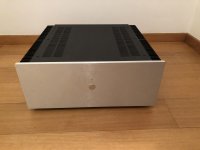 88F316E6-E3E4-438A-8752-B0A814244689.jpg735.6 KB · Views: 1,291
88F316E6-E3E4-438A-8752-B0A814244689.jpg735.6 KB · Views: 1,291 -
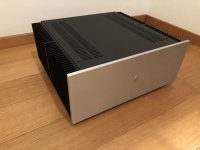 D0F9FDF1-036A-436F-8AE1-39D6020134D1.jpg667.9 KB · Views: 1,232
D0F9FDF1-036A-436F-8AE1-39D6020134D1.jpg667.9 KB · Views: 1,232 -
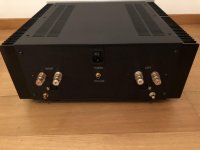 C24C4730-C78C-4911-9D54-64AF0E48F64E.jpg635.5 KB · Views: 1,332
C24C4730-C78C-4911-9D54-64AF0E48F64E.jpg635.5 KB · Views: 1,332 -
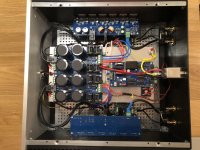 5C0586B6-3983-41B8-865C-86948A136AB5.jpg984.2 KB · Views: 1,383
5C0586B6-3983-41B8-865C-86948A136AB5.jpg984.2 KB · Views: 1,383 -
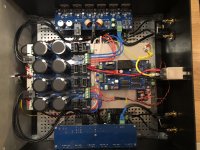 023FD62B-29F4-4B54-AE5E-CF57DE0BA422.jpg996.2 KB · Views: 1,188
023FD62B-29F4-4B54-AE5E-CF57DE0BA422.jpg996.2 KB · Views: 1,188
Last edited:
WOW amazing build and very detailed info! I'm building my 2xModulus-86 bu nonetheless I can learn stuff from this as well
Could you give a little more info on the input connections? ie do the XLR and SE get tied somehow before going into the amps? I mean, are you able to get both balanced and unbalanced into the amp? Thank youFinally i completed the last things in my build of the Modulus 686 and it is time to share some pictures and experiences.
(...)
- Two neutrik xlr connectors
- Two neutrik cinch connectors for single ended access —> this does require a cardass jumper in the XLR chassis connectors to work
daansan,
Holy crap! What a superb build with execution! Really happy and proud of you! Enjoy the fruits of your efforts and get yourself a serious dac!
Do you mind posting a pic with the power on?
Best,
Anand.
Holy crap! What a superb build with execution! Really happy and proud of you! Enjoy the fruits of your efforts and get yourself a serious dac!
Do you mind posting a pic with the power on?
Best,
Anand.
If you standardize on 4 connector Speak-ons, you could use a single speakon connector to a biamped speaker. So Tom could build 2 stereo 686’s and have a single speakon connector go to each of his Lx-minis. I was planning to wire up all my amps that way.
I need a diagram to be able to understand this 🙁
WOW amazing build and very detailed info! I'm building my 2xModulus-86 bu nonetheless I can learn stuff from this as well
Could you give a little more info on the input connections? ie do the XLR and SE get tied somehow before going into the amps? I mean, are you able to get both balanced and unbalanced into the amp? Thank you
I basically followed Tom’s suggestions for the pseudo differential cable. I wired the single ended connector to the XLR connector. For the SE connectors to work i do need to short ground to the negative pin (doing this out of the top of my mind). I can short them using a cardas shorting plug like in the image attached, i simply put it in the xlr connector.
Attachments
daansan,
Holy crap! What a superb build with execution! Really happy and proud of you! Enjoy the fruits of your efforts and get yourself a serious dac!
Do you mind posting a pic with the power on?
Best,
Anand.
Thanks! I’ll make a picture when I’m at home with the amp on!
I basically followed Tom’s suggestions for the pseudo differential cable. I wired the single ended connector to the XLR connector. For the SE connectors to work i do need to short ground to the negative pin (doing this out of the top of my mind). I can short them using a cardas shorting plug like in the image attached, i simply put it in the xlr connector.
cool, but that will allow you to use either XLR or SE, right? ie like having a preamp output in SE to the SE input and another preamp balanced out into the XLR input?
cool, but that will allow you to use either XLR or SE, right? ie like having a preamp output in SE to the SE input and another preamp balanced out into the XLR input?
No, you have to choose.. without the jumper i use the balanced connectors, with the jumper i can use the se connectors but not the balanced connectors.
No, you have to choose.. without the jumper i use the balanced connectors, with the jumper i can use the se connectors but not the balanced connectors.
Good enough, thank you!
daansan - Vancouver is rather a lengthy road trip from Tom’s Calgary stompin’ grounds, but if you are inspired to make a trip to the wet coast - specifically lower Vancouver Island, I’d be willing to act as intermediary for any beverage appreciation ceremonies. 😉
Nice build, and isn’t that a gorgeous “sounding” (i.e. none) amp, and really hella value compared to commercial pieces of equivalent performance?
Nice build, and isn’t that a gorgeous “sounding” (i.e. none) amp, and really hella value compared to commercial pieces of equivalent performance?
I need a diagram to be able to understand this 🙁
You can see the speakON connection diagrams for various configurations here: Neutrik speakON Wiring Suggestion.
Tom
WOW amazing build and very detailed info! I'm building my 2xModulus-86 bu nonetheless I can learn stuff from this as well
Could you give a little more info on the input connections? ie do the XLR and SE get tied somehow before going into the amps? I mean, are you able to get both balanced and unbalanced into the amp? Thank you
You can run all the Modulus amps with either a differential/balanced input (recommended) or single-ended/unbalanced input.
For differential/balanced, the connections are simple:
XLR pin 1 -> Modulus input pin 1
XLR pin 2 -> Modulus input pin 2
XLR pin 3 -> Modulus input pin 3
For single-ended/unbalanced, life gets slightly more complicated:
RCA centre -> Modulus input pin 2
RCA shell -> Modulus input pins 1 and 3
You can also use the pseudo-differential cable I show on my website.
Note that with single-ended/unbalanced connections, you do not get the benefits of the differential/balanced input. In this case, the Modulus will perform every bit as good as any other amp with a single-ended input but you won't get the hum reduction of the differential input. To take advantage of the differential input, you have to use differential connections from source to amp.
It is possible to have the XLR and RCA connectors wired together, thereby allowing the connection of either a differential source or a single-ended source. However, you cannot have both connected at the same time as the output of one source will load the output of the other source. Also, as pointed out above, you have to make sure that you connect pins 1 and 3 on the XLR connector together.
In my view, just connecting the RCA and XLR connectors together is a bit of a hack. I would prefer to have a switch to change between RCA and XLR input.
Tom
Correct, that was the purpose. Makes sense. Thank you again!It is possible to have the XLR and RCA connectors wired together, thereby allowing the connection of either a differential source or a single-ended source. However, you cannot have both connected at the same time as the output of one source will load the output of the other source. Also, as pointed out above, you have to make sure that you connect pins 1 and 3 on the XLR connector together.
In my view, just connecting the RCA and XLR connectors together is a bit of a hack. I would prefer to have a switch to change between RCA and XLR input.
Tom
You could also use a Neutrik combo connector in lieu of a switch. Only one type could be used at a time. This is what I am planning to use.
Combo I Series - Neutrik
Combo I Series - Neutrik
THAT'S PRETTY AWESOME! 😱 THANK YOUYou could also use a Neutrik combo connector in lieu of a switch. Only one type could be used at a time. This is what I am planning to use.
Combo I Series - Neutrik

I really dislike RCA connectors. 🙂
Part of the reason for building DIY stuff is you can get your gear just like you want it. Only RCA connections that I am putting in is the phono input, since I have RCAs on it.
Part of the reason for building DIY stuff is you can get your gear just like you want it. Only RCA connections that I am putting in is the phono input, since I have RCAs on it.
- Home
- Vendor's Bazaar
- Modulus-686: 380W (4Ω); 220W (8Ω) Balanced Composite Power Amp with extremely low THD
